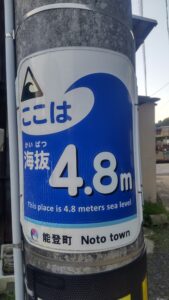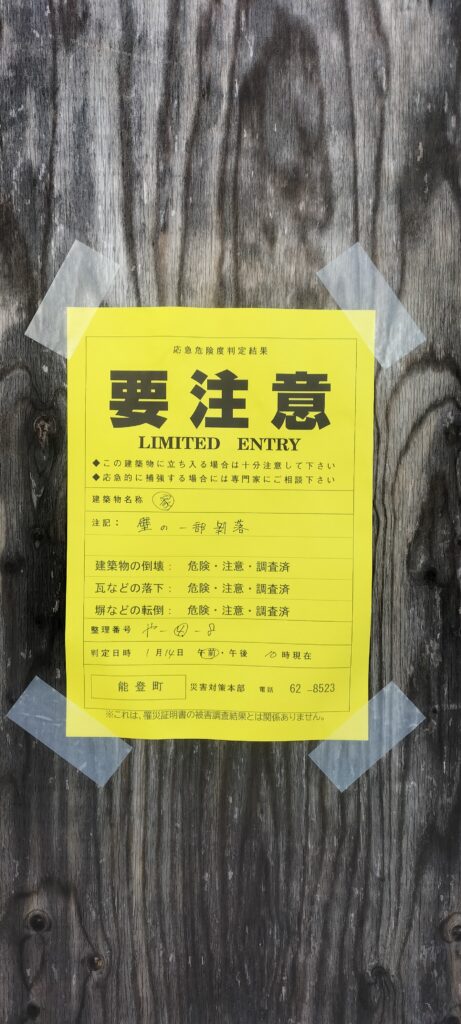Recognizing the significance of these signs and similar ones to these across Japan can help you to navigate through disasters and enhances your chances of survival during such events.




Being aware and prepared is not just a precaution; it’s an essential strategy for navigating potential disasters. If you’re a long-term resident in Japan, like I am, or planning to make this vibrant country your home, it’s vital to recognize that the likelihood of encountering a disaster increases over time and to be prepared for them.
Visiting Japan can be an enjoyable and unforgettable experience for tourists. However, there are growing concerns about the threat of the Nanki Trough Earthquake and other potential disasters throughout the country. With the increasing number of travelers, the risk of encountering such disasters is also rising.
Regardless of whether you’re here for a holiday or sightseeing, it is crucial to be informed and prepared for anything. Being aware of your surroundings and understanding some essential Japanese vocabulary can make all the difference in ensuring your safety and well-being during your time in Japan.
Almost all Japanese do not speak a foreign language
Most Japanese people do not know how to speak any foreign languages. Although English and some other languages are taught in schools, the focus is primarily on grammar rather than conversational skills. As a result, many Japanese individuals do not learn how to speak English, German, or Chinese in a conversational context. They try to avoid any interactions with foreigners, especially if they know you can’t speak Japanese.
Large earthquakes can lead to widespread electricity blackouts and internet outages that may last for days or even weeks. For example, during the Noto Peninsula Earthquake, there was no electricity for several days, and the internet was down for weeks. In such situations, you won’t be able to charge your phone or access the internet at all, and translation programs will also be unavailable. Therefore, it is essential to learn as much Japanese as possible to navigate and survive until infrastructure is restored.
Earthquake Disaster Vocabulary Word List:
- 地震 じしん Ji shin Earthquake
- 津波 つなみ Tsu na mi Tsunami
- 土砂崩れ どしゃくずれ do sya ku zure Landslide
- 洪水 こうずい kou zui flooding
- 川が溢れた かわがあふれた ka wa ga a fu re ta The river has overflowed its banks.
- 火事 かじ ka ji Fire
- 森林火災 しんりんかさい Shin rin ka sai Forest Fire
- 雪崩 なだれ Na da re avalanche
- 噴火 ふんか fun ka Volcanic eruption
- 爆発 ばくはつ ba ku ha tsu explosion
The words in the list above can be applied to various disasters. In the case of earthquakes, the earthquake itself is only the beginning. Earthquakes can trigger a multitude of disasters, including gas explosions in cities, electrical fires, forest fires, avalanches on mountains, and landslides that may cause rivers to overflow. Earthquakes can also generate tsunamis, leading to further flooding. This is why it is important to be familiar with these terms, especially during earthquakes.
List of Terms Relating to Injuries and Seeking Help:
- 助けて たすけて ta su ke te Help
- 病院 びょういん byou in Hospial
- クリニック くりにっく kurinikku
- 医者 いしゃ i sya Doctor
- 救急車 きゅうきゅうしゃ kyuu kyuu sya ambulience
- 怪我 けが kega injury
- 怪我ありますか けがありますか kega arimasu ka? Are you injured?
- きず kizu cut/wound (sometimes bleeding, it could be also used to describe a gash, scare, bruse, or scrape)
- 痛みありますか? いたみありますか? itami arimasuka? Are you in pain?
- はい hai Yes
- いいえ iie No
- 痛い いたい itai pain/hurt
- ____が痛い _______がいたい ______ ga itai. My ________ hurts.
- 頭が痛い あたまがいたい atama ga itai My head hurts
- 左 ひだり hidari Left
- 右 みぎ みぎ migi right
- 腕が痛い うでがいたい ude ga itai My arm hurts
- 足が痛い あしがいたい ashi ga itai My foot hurts
- 足が動かない あしがうごかない ashi ga ugokanai I can’t move my foot
- 動かない うごかない ugokanai I can’t move
- 血が出ています ちがでています chi ga deteimasu I’m bleeding
- どこが痛いですか どこがいたいですか doko ga itai desu ka? Where does it hurt?
This is a quick list of helpful words used if you’re injured in Japan in any circumstance.
Vocabulary for people who come to the rescue during emergencies.
- 消防士 しょうぼうし shou bou shi F ireman
- 消防署 しょうぼうしょ shou bou sho Firestation
- 消防車 しょうぼうしゃ shou bou sya Fire Engine
- 警報 けいさつ kei satsu Police
- 119 Emergency phone number for the ambulance and fire brigade in Japan
- 110 Emergency phone number for Police in Japan
- 自衛隊 じぇいたい je itai Japanese self defence force (Deployed during disasters)
List of words for shelters and evacuating
- 避難 ひなん Hi nan Taking Refuge/Finding shelter
- 避難路 ひなんろ hi nan ro Evauation route/escape route
- 避難所 ひなんじょ hi nan jo Evacuation shelter (Evacuation shelters in Japan are found usually in local schools, community centers, town halls, city halls, or other government buildings).
- 避難階段 ひなんかいだん hi nan kai dan Emergency stairs
- 避難はしご ひなんはしご hi nan ha shi go Fire Escape/ Fire Escape ladder. Also sometimes written in katakana as 避難ハシゴ hi nan ha shi go.
- 消火器 しょうかき shou ka ki Fire Extinguisher
- 小学校 しょうがっこう shou gakkou Elementary school
- 中学校 ちゅうがっこう chuu gakkou Junior High School
- 高校 こうこう kou kou High School
- 役場 やくば ya ku ba Town Hall
- 市役所 しやくしょ shi ya ku sho City hall
- 区役所 くやくしょ ku ya ku sho Ward Office (Wards are usually located in larger cities like Kyoto, Osaka, and Nagoya).
- 行政センター ぎょうせいセンター gyou se sentaa Government administration office
- 公民館 こうみんかん kou min kan Community Center/Public Hall
- 体育館 たいいくかん tai i ku kan Gymnasium
- 避難者 ひなんしゃ hi nan sya Evacuee
The words listed above are helpful for locating places of refuge during disasters. Many disaster shelters are typically found in town halls, schools, community centers, or gyms. I also included terms such as “fire escape,” “fire extinguisher,” and “emergency stairs,” as these can assist you in safely exiting hotels or buildings you may be inside.
Here is a sign for an evacuation shelter in my town. This serves as an example of what to look for if you find yourself in a disaster situation. Evacuation shelters are usually easy to locate in the country side; however, in large cities or densely populated regions in Japan, there may be no signs, making it difficult to find an evacuation shelter. In larger populated areas and large cities dangers can arise from anywhere it might even be difficult to find a place of refuge.

Vocubalary list for words of caution in Japan
- 禁止 きんし kin shi PROHIBITED/BANNED, ABSOLUTELY DO NOT DO IT!!
- 立ち入り禁止 たちいりきんし ta chi i ri kin shi ABSOLUTELY DO NOT ENTER!!
- 通行 つうこう Tsuu kou passing through/ driving through
- 通行禁止 つうこうきんし tsuu kou kin shi No entry/Road closed/ Do not walk pass/ Do not pass this way.
- 禁煙 きんえん kin en DO NOT SMOKE
- 使用禁止 しようきんし shi you kin shi ABSOULTELY DO NO USE AT ALL!!
- 注意 ちゅうい chuu i Attention/Notice (You will normally see this in a warning to be careful of something).
- 危険 きけん ki ken DANGER
- 要注意 ようちゅうい you chuu i Need for Caution
- ご注意ください ごちゅういください go chuu i ku da sai Please be aware.
If you see any signs on sidewalks, roads, toilets, or anywhere else, understand their meanings and follow them exactly. Taking caution is crucial after earthquakes, especially if you’re in the disaster zone.
A Bonus for Residence of Japan
If you live in Japan or have been a long-term resident of a town where you have purchased a home, it’s important to be aware of the following information if you are located in or near a major earthquake disaster zone:
A few days or weeks after a major earthquake that has caused a significant amount of damage, you will start to see a red, yellow, or green sign posted on a building. Here is an example of one:

This yellow sign indicates limited entry to the building. You will see these signs placed on homes, shops, and other buildings where a government official has conducted a quick inspection of the exterior.
The phrase 要注意 (ようちゅうい) means “take caution” when you are near or entering this building.
The red sign posted on a building after an earthquake indicates 危険 (Unsafe). When you see this sign, it means that the building is at risk of collapsing or poses other dangers. These buildings should be avoided.
Green signs that say 調査済 (ちょうさずみ) mean “inspected.” When you see green signs on shops and businesses, it indicates that the exterior has been inspected and found to be safe.
This also means that the interior of the building, the ground it is built on, and its foundation have NOT been inspected. Regardless of the color noted on the building, you should exercise caution when moving around in a disaster area that has been affected by a large earthquake, whether for days, weeks, or even months.
Conclusion
This post is not intended as a Japanese language lesson or a guide on how to speak Japanese. Instead, the vocabulary included here is designed to help you become familiar with common terms that can assist you during disasters. I am currently writing a book on reading Japanese Hiragana and Katakana, as well as basic conversational Japanese. I will continue to share more information on how to communicate and navigate through disasters in Japan, whether you are living in the country or traveling through it.
Leave a Reply